An SPRi Biosensor for Determination of the Ovarian Cancer Marker HE4 in Human Plasma
Abstract
1. Introduction
2. Experimental
2.1. Materials and Reagents
2.2. Biological Material
2.3. Procedures
2.3.1. Antibody Immobilization
2.3.2. SPRi Measurements
3. Results and Discussion
3.1. Optimization of Antibody Concentration
3.2. Dependence of the Analytical Signal on HE4 Concentration. Calibration Graph
3.3. Precision and Recovery. Limit of Detection
3.4. Specificity of the Developed Biosensor
3.5. Validation of the Developed Biosensor
3.6. Example of Diagnostic Application
4. Conclusions
Author Contributions
Funding
Institutional Review Board Statement
Informed Consent Statement
Data Availability Statement
Acknowledgments
Conflicts of Interest
Appendix A
Appendix A.1. Materials
Appendix A.2. Apparatus and Chip Architecture
Appendix A.3. Optimization of Concentration of Rabbit Polyclonal Antibody against HE 4
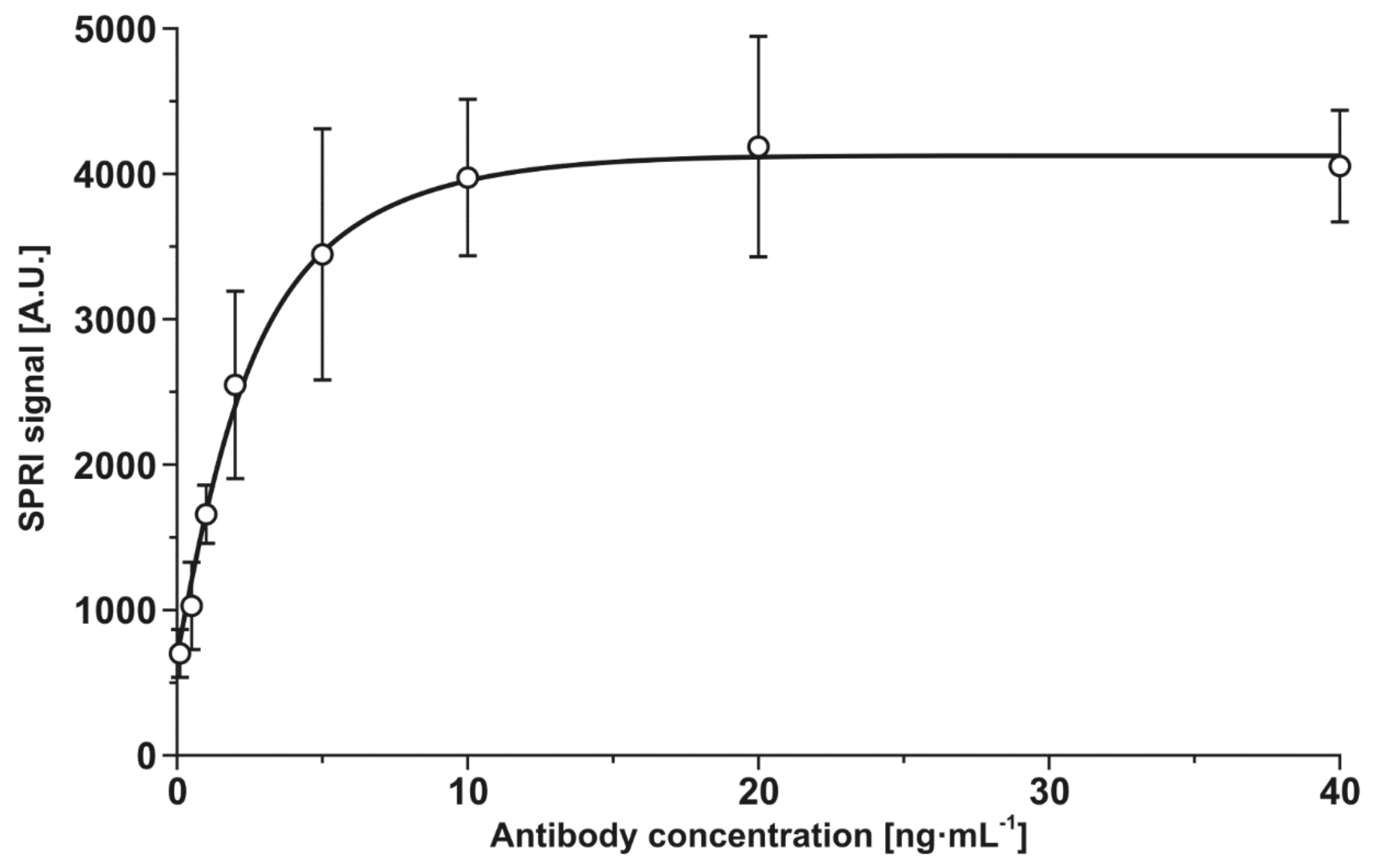
References
- Granato, T.; Porpora, M.G.; Longo, F.; Angeloni, A.; Manganaro, L.; Anastasi, E. HE4 in the differential diagnosis of ovarian masses. Clin. Chim. Acta 2015, 446, 147–155. [Google Scholar] [CrossRef] [PubMed]
- Kappelmayer, J.; Antal-Szalmás, P.; Nagy, B., Jr. Human epididymis protein 4 (HE4) in laboratory medicine and an algorithm in renal disorders. Clin. Chim. Acta 2015, 438, 35–42. [Google Scholar] [CrossRef] [PubMed]
- Bingle, L.; Singleton, V.; Bingle, C.D. The putative ovarian tumour marker gene HE4 (WFDC2), is expressed in normal tissues and undergoes complex alternative splicing to yield multiple protein isoforms. Oncogene 2002, 21, 2768–2773. [Google Scholar] [CrossRef] [PubMed]
- Anastasi, E.; Marchei, G.G.; Viggiani, V.; Gennarini, G.; Frati, L.; Reale, M.G. HE4: A new potential early biomarker for the recurrence of ovarian cancer. Tumor Biol. 2010, 31, 113–119. [Google Scholar] [CrossRef]
- Fan, Q.; Luo, G.; Yi, T.; Wang, Q.; Wang, D.; Zhang, G.; Jiang, X.; Guo, X. Diagnostic value of urinary-to-serum Human Epididymis Protein 4 ratio in ovarian cancer. Biomed. Rep. 2017, 7, 67–72. [Google Scholar] [CrossRef]
- Ferraro, S.; Borille, S.; Carnevale, A.; Frusciante, E.; Bassani, N.; Panteghini, M. Verification of the harmonization of human epididymis protein 4 assays. Clin. Chem. Lab. Med. 2016, 54, 1635–1643. [Google Scholar] [CrossRef]
- Ferraro, S.; Panteghini, M. Making new biomarkers a reality: The case of serum human epididymis protein 4. Clin. Chem. Lab. Med. (CCLM) 2018, 57, 1284–1294. [Google Scholar] [CrossRef]
- Yuan, J.; Duan, R.; Yang, H.; Luo, X.; Xi, M. Detection of serum human epididymis secretory protein 4 in patients with ovarian cancer using a label-free biosensor based on localized surface plasmon resonance. Int. J. Nanomed. 2012, 7, 2921–2928. [Google Scholar] [CrossRef]
- Duan, R.; Xi, M. A Novel Label-Free Biosensor for Detection of HE4 in Urine Based on Localized Surface Plasmon Resonance and Protein G Directional Fixed. J. Nanomater. 2020, 8613240. [Google Scholar] [CrossRef]
- Wang, C.; Ye, X.; Wang, Z.; Wu, T.; Wang, Y.; Li, C. Molecularly Imprinted Photo-electrochemical Sensor for Human Epididymis Protein 4 Based on Polymerized Ionic Liquid Hydrogel and Gold Nanoparticle/ZnCdHgSe Quantum Dots Composite Film. Anal. Chem. 2017, 89, 12391–12398. [Google Scholar] [CrossRef]
- Fu, X.; Liu, Y.; Qiu, R.; Foda, M.F.; Zhang, Y.; Wang, T.; Li, J. The fabrication of magnetic particle-based chemiluminescence immunoassay for human epididymis protein-4 detection in ovarian cancer. Biochem. Biophys. Rep. 2018, 13, 73–77. [Google Scholar] [CrossRef]
- Szymanska, B.; Lukaszewski, Z.; Hermanowicz-Szamotowicz, K.; Gorodkiewicz, E. A biosensor for determination of the circulating biomarker CA125/MUC16 by Surface Plasmon Resonance Imaging. Talanta 2020, 206, 120187. [Google Scholar] [CrossRef]
- Gorodkiewicz, E. The Surface Plasmon Resonance Imaging Sensor for Papain Based on Immobilized Cystatin. Protein Pept. Lett. 2007, 14, 443–445. [Google Scholar] [CrossRef]
- Tokarzewicz, A.; Romanowicz, L.; Sveklo, I.; Gorodkiewicz, E. The development of a matrix metalloproteinase-1 biosensor based on the surface plasmon resonance imaging technique. Anal. Methods 2016, 8, 6428–6435. [Google Scholar] [CrossRef]
- Sankiewicz, A.; Tokarzewicz, A.; Gorodkiewicz, E. Regeneration of surface plasmone resonance chips for multiple use. Bulgar. Chem. Commun. 2015, 47, 477–482. [Google Scholar]
- Gorodkiewicz, E.; Lukaszewski, Z. Recent Progress in Surface Plasmon Resonance Biosensors (2016 to Mid-2018). Biosensors 2018, 4, 132. [Google Scholar] [CrossRef]
- Falkowski, P.; Lukaszewski, Z.; Gorodkiewicz, E. Potential of Surface Plasmon Resonance Biosensors in cancer detection. J. Pharm. Biomed. Anal. 2021, 194, 113802. [Google Scholar] [CrossRef]
- Gasiorowska, E.; Kluz, T.; Lipski, D.; Warchoł, W.; Tykarski, A.; Nowak-Markwitz, E. Human Epididymis Protein 4 (HE4) Reference Limits in Polish Population of Healthy Women, Pregnant Women, and Women with Benign Ovarian Tumors. Dis. Markers 2019, 3890906. [Google Scholar] [CrossRef]
- Sankiewicz, A.; Romanowicz, L.; Laudanski, P.; Zelazowska-Rutkowska, B.; Puzan, B.; Cylwik, B.; Gorodkiewicz, E. SPR imaging biosensor for determination of laminin-5 as a potential cancer marker in biological material. Anal. Bioanal. Chem. 2016, 408, 5269–5276. [Google Scholar] [CrossRef]
- Sankiewicz, A.; Lukaszewski, Z.; Trojanowska, K.; Gorodkiewicz, E. Determination of collagen type IV by Surface Plasmon Resonance Imaging using a specific biosensor. Anal. Biochem. 2016, 515, 40–46. [Google Scholar] [CrossRef]
- Wang, X.; Hou, T.; Lin, H.; Lv, W.; Li, H.; Li, F. In situ template generation of silver nanoparticles as amplification tags for ultrasensitive surface plasmon biosensing of microRNA. Biosens. Bioelectron. 2019, 137, 82–87. [Google Scholar] [CrossRef] [PubMed]
- Li, H.; Chang, J.; Hou, T.; Li, F. HRP mimicking DNAzyme-catalyzed in situ generation of polyaniline to assist signal amplification for ultrasensitive Surface Plasmon Resonance biosensing. Anal. Chem. 2017, 89, 673–680. [Google Scholar] [CrossRef] [PubMed]
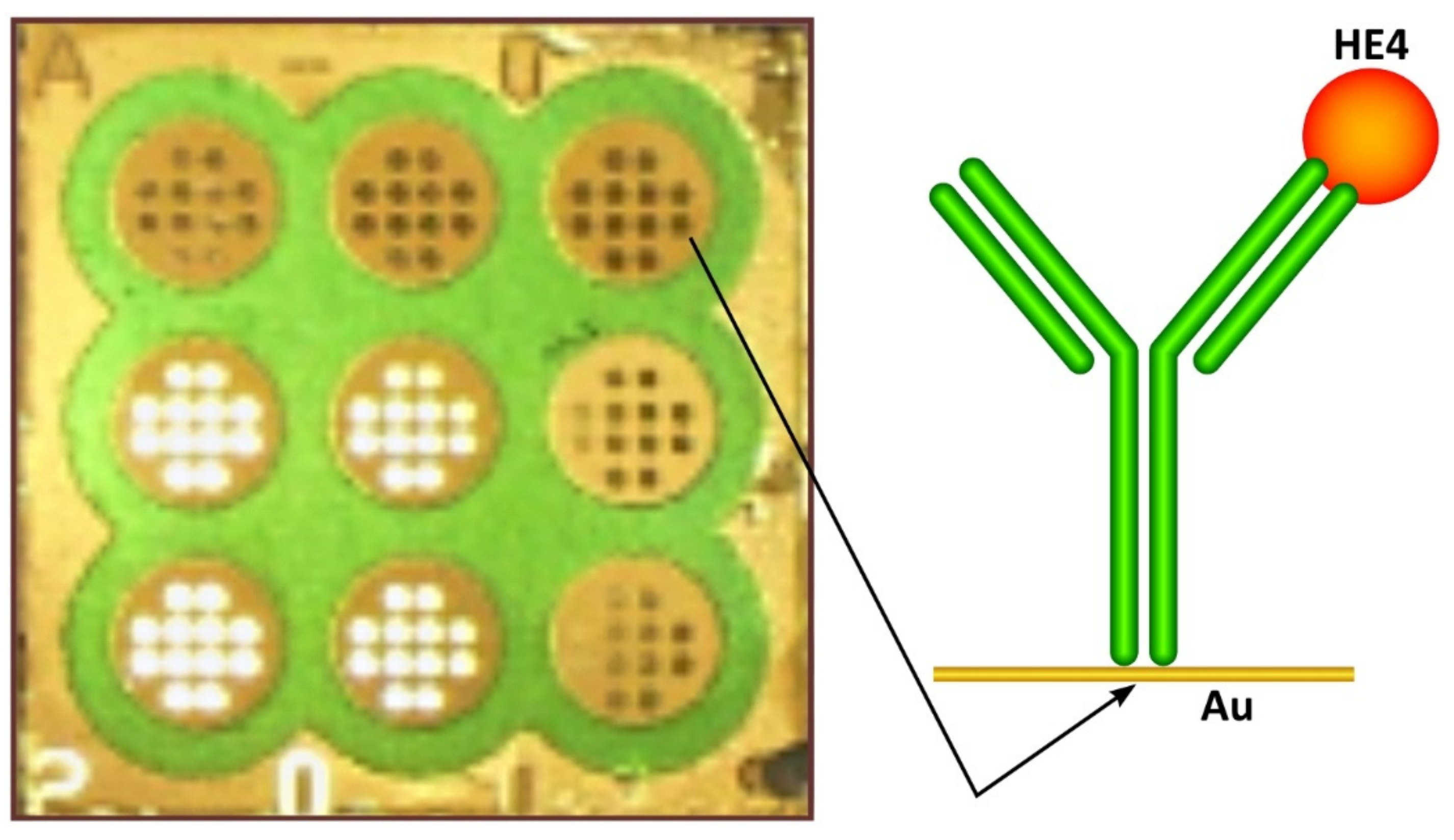
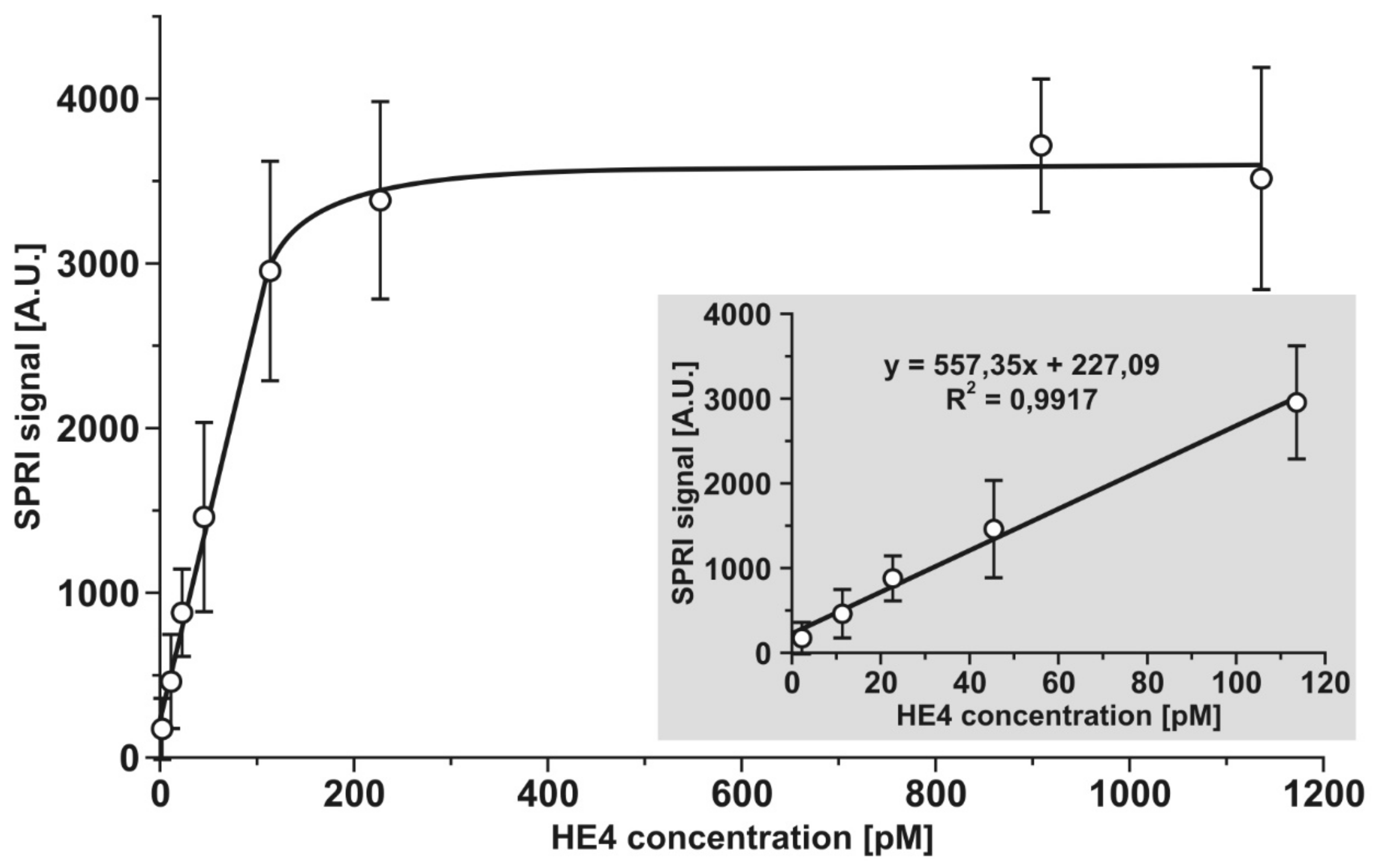
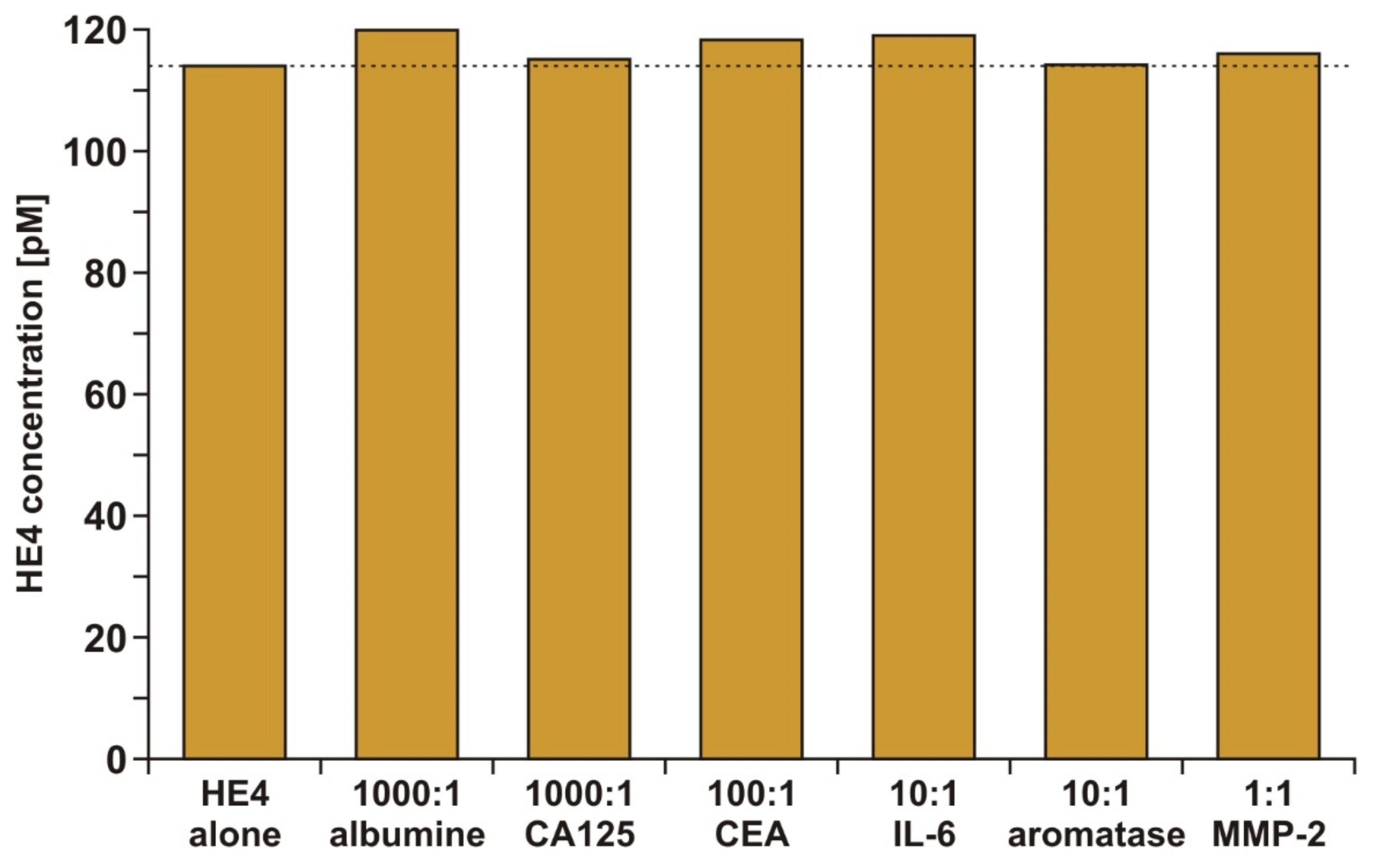

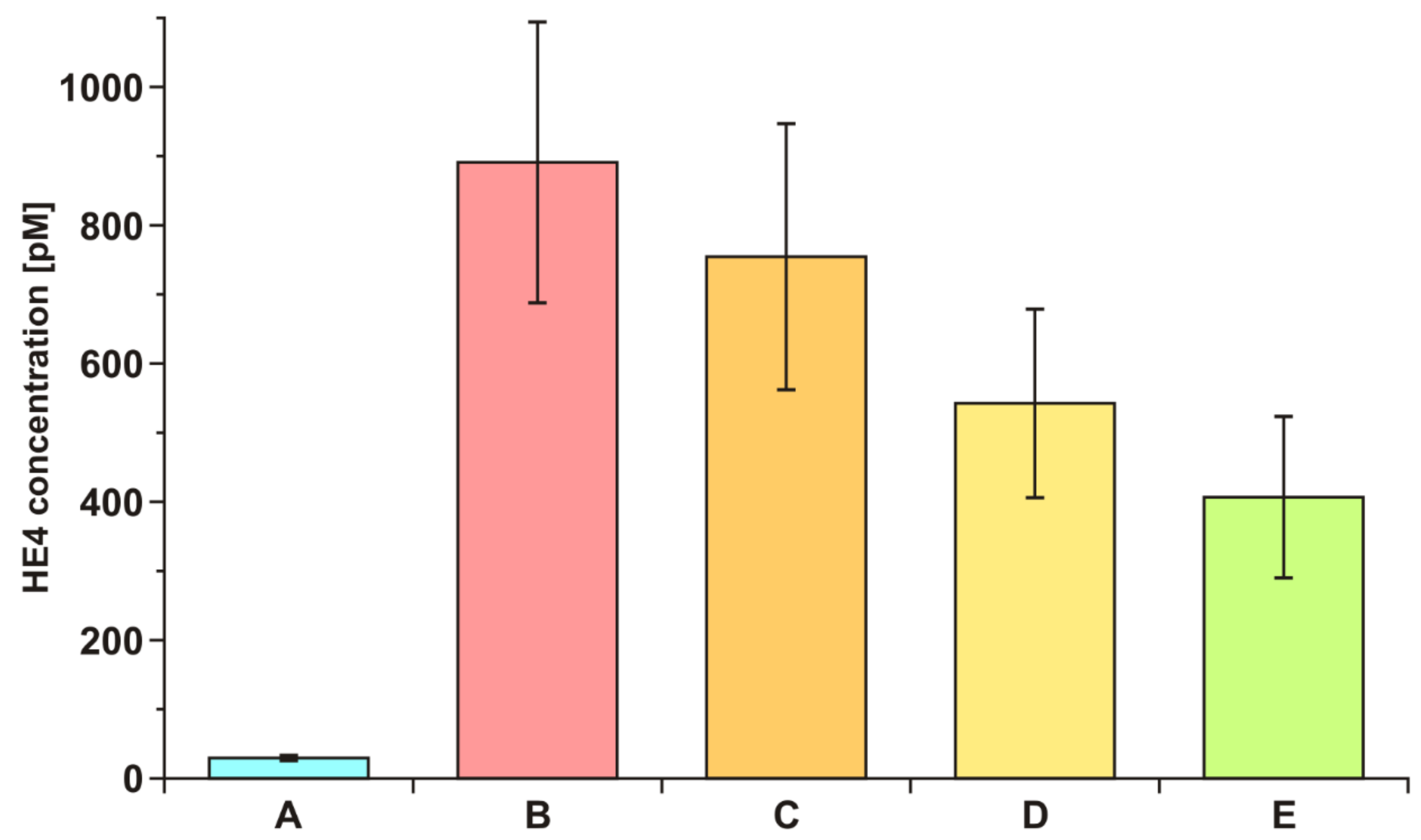
| Added (pM) | Found (pM) | SD (pM) | RSD (%) | Recovery (%) |
|---|---|---|---|---|
| 11.4 | 11.6 | 0.68 | 6.0 | 101.8 |
| 45.5 | 46.5 | 4.5 | 9.9 | 102.1 |
| 114 | 118 | 11 | 9.6 | 103.5 |
Publisher’s Note: MDPI stays neutral with regard to jurisdictional claims in published maps and institutional affiliations. |
© 2021 by the authors. Licensee MDPI, Basel, Switzerland. This article is an open access article distributed under the terms and conditions of the Creative Commons Attribution (CC BY) license (https://creativecommons.org/licenses/by/4.0/).
Share and Cite
Szymanska, B.; Lukaszewski, Z.; Zelazowska-Rutkowska, B.; Hermanowicz-Szamatowicz, K.; Gorodkiewicz, E. An SPRi Biosensor for Determination of the Ovarian Cancer Marker HE4 in Human Plasma. Sensors 2021, 21, 3567. https://doi.org/10.3390/s21103567
Szymanska B, Lukaszewski Z, Zelazowska-Rutkowska B, Hermanowicz-Szamatowicz K, Gorodkiewicz E. An SPRi Biosensor for Determination of the Ovarian Cancer Marker HE4 in Human Plasma. Sensors. 2021; 21(10):3567. https://doi.org/10.3390/s21103567
Chicago/Turabian StyleSzymanska, Beata, Zenon Lukaszewski, Beata Zelazowska-Rutkowska, Kinga Hermanowicz-Szamatowicz, and Ewa Gorodkiewicz. 2021. "An SPRi Biosensor for Determination of the Ovarian Cancer Marker HE4 in Human Plasma" Sensors 21, no. 10: 3567. https://doi.org/10.3390/s21103567
APA StyleSzymanska, B., Lukaszewski, Z., Zelazowska-Rutkowska, B., Hermanowicz-Szamatowicz, K., & Gorodkiewicz, E. (2021). An SPRi Biosensor for Determination of the Ovarian Cancer Marker HE4 in Human Plasma. Sensors, 21(10), 3567. https://doi.org/10.3390/s21103567








